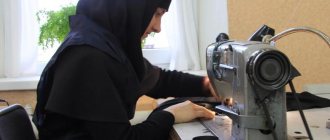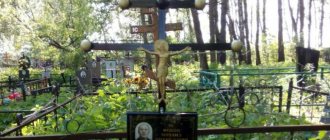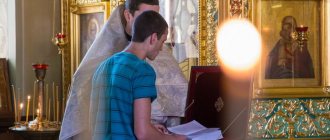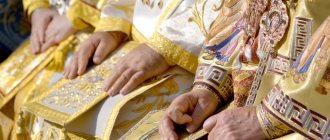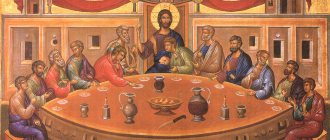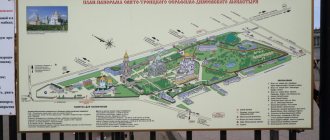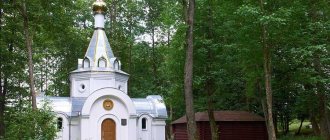Ostrog, Montenegro
The monastery is located high in the mountains, in the Ostroshka Greda rock. The Orthodox Church is one of the most visited places in Montenegro; several thousand tourists come here every year. Metropolitan Basil of Ostrog of Herzegovina founded it in the 17th century. The monastery is visited by a huge number of people because they believe that if you pray next to the metropolitan’s body, all illnesses and adversities will go away.
Women's Orthodox hermitages
Seraphim-Znamensky Skete
The monastery, located in the south of the Moscow region, is known to all Christians as a place where Faith, Hope and true Love truly reign. The monastery has gone through many trials and difficult times, but now spiritual life within its walls is being revived.
Seraphim-Znamensky Monastery in Domodedovo
Pokrovsky Skete
The monastery is located in a dense forest in the Leningrad region. The nuns living in the monastery have learned to combine service to God and social activities - they help people suffering from drug addiction.
Meteora, Greece
Meteora is located on sandstone, in the mountains of Thessaly, in central Greece. Meteora is an Orthodox church, but more importantly a UNESCO World Heritage Site with perhaps the most amazing history. As legend has it, the monastery was founded by St. Athanasius. In order to plant his flag on the top of the mountain, he did not need to walk; an eagle carried him to the mind-boggling height.
Visitors can only reach the summit via a staircase carved into the rock. Until 1920, people climbed up using ropes and pulleys, and in the 14th century, when the temple was already built, in order to transport anything to a height of 550 m, loops and nets had to be lowered down. This place is also popular for its presence in the James Bond film For Your Eyes Only.
Travel to Karelia
Tours to Karelia from Moscow to Valaam are readily offered by numerous travel agencies. At your request, you can choose the duration of the trip from two to eighteen days. Tours to Karelia to Valaam are carried out all year round. In summer, in addition to the sights, you can enjoy the romance of the white nights. If you add fishing and walks surrounded by pristine nature, your vacation will undoubtedly be memorable and successful. Holidays in Karelia on Valaam, in the country of forests and lakes, will allow you to completely disconnect from the busy life of the metropolis and enjoy peace and quiet.
In winter, especially during the New Year holidays, it is nice to pamper your child with an acquaintance with Chukchi sled dogs: Siberian Huskies with blue eyes, Alaskan Malamutes, Taimyr sled dogs. The mushers will teach you how to harness dogs to sleds. And how interesting it is to ride along the two-kilometer track on the dogs of the famous traveler Fyodor Konyukhov! It's easy for them. After all, they walked with him the most difficult path from the North Pole to Canada across the Arctic ice. Then you will be invited to drink hot tea in the tent and eat red fish soup. The next day, cheerful gnomes will surround you, divide the group into teams and begin competitions. And this is not all that will be offered to you! Santa Claus will also appear.
Kozheozersky Monastery
The Kozheozersky Orthodox monastery is located in the most remote part of the world, next to Lake Kozhozero, in northwestern Russia. Founded in 1500. It is very difficult to get to the temple, as there is no road leading here. Those who want to visit such a remote place will first have a train ride, and after disembarking at the Nimenga station, another trip, this time by car, through the forest (if, of course, you can catch it or have to walk).
Well, in the end, you will need to walk 32 km. But even after such a long journey, the last obstacle must be overcome - the lake. A boat will transport you to the other shore; you just need to light a flame and wait. Of course, you should forget about electricity and the Internet while visiting the monastery. So before the trip, it is better to tell your family where you are going.
Orthodox monasteries in Russia
When it comes to the monastery movement in Russia, it is most often associated with asceticism and Old Believers.
Old Believer monasteries arose in Russia after a certain part of the clergy did not accept the church reform adopted by Patriarch Nikon and Tsar Alexei Mikhailovich Romanov. The Old Believers were persecuted by the laws of that time, so opponents of the reform were forced to found monastic settlements far from the settlements of the laity.
Old Believer monastery in the Chelyabinsk region
In the Old Believers, the monastery was a generally accepted name. Both small monasteries and large monastic settlements were called this way. A classic example of such a monastery can be considered the Komarovsky monastery. Contemporaries of the first Old Believer hermitages describe them as solid buildings.
The monastic compound consisted of several communal-type cells, temples and good-quality outbuildings. Often all the buildings were connected to each other by secret passages. However, hermitage settlements should not always be associated with the Old Believer movement. Hermitages were often founded by hermits who strove for an ascetic lifestyle.
It is important to know! The word asceticism in Orthodoxy usually means a strict way of life, associated with the voluntary renunciation of various household and material goods.
If we talk about the hermit lifestyle, the monasteries of the Solovetsky Islands and the island of Valaam come to mind first.
Gompa Fuktal, India
The monastery is located in the southeast of the Zanskar region, in the Himalayas. The building is carved out of rock, 3800 m high. Approximately 70 monks live here. Lama Gansem Sherab Sampo founded this extraordinary monastery in the 12th century. In addition, what is also unusual is that, being constructed from clay, brick and wood, the temple has stood for more than 100 years .
Taktsang Lhakhang, Bhutan
Taktsang-lakhang or as it is also called “Tiger's Nest” is located in a very dangerous place, at an altitude of 3000 m, on the slope of a cliff, in the Paro Valley. According to legend, the second Buddha, Guru Rinpoche, was looking for a cave for meditation, and found it in Bhutan, where he arrived on the back of a huge tigress. In 1692, a monastery was built on the site of this very cave. In 1998 it was reconstructed. You can only get here on foot or riding a mule. Tourists are not allowed.
Mountain Park "Ruskeala"
On the territory of the park there is an abandoned marble quarry with a length of 460 meters. Marble of 4 colors was mined at the deposit - ash-gray, gray-green, white with gray veins and white-blue-gray. This stone was used in St. Isaac's and Kazan Cathedrals, in the Hermitage and the St. Petersburg metro stations "Primorskaya" and "Ladozhskaya".
The “Underground Ruskeala” excursion is conducted through a quarry filled with groundwater. About 300 LED lights illuminate the grottoes and adits. The Marble Lake Walk offers views of the canyon and Marble Cave from the water. On the excursion “The Road of Mountain Masters” you can see the “Italian Quarry” and an underground lake in the shape of a heart.
Xuankong-si, China
The Hanging Monastery is located in Shanxi Province, China, with a beautiful view of Mount Heng. If you look at the temple for the first time, you get the feeling that as soon as a strong wind blows, the building will immediately fall down. But, probably, God protects the monastery (or it was designed by a good engineer), because it withstood earthquakes.
The atmosphere inside the temple is quite extraordinary, because the walls in the rooms follow the contours of the rock. The building was built 1400 years ago. It is not only sustainable, but also has enormous architectural value. So how does the monastery manage to withstand wind and earthquakes? The thing is that smart engineers, while building it, drove piles into the rock from which the temple was carved.
Recommendations for tourists
The island of Valaam, where the monastery complex has long been located, annually attracts not only numerous pilgrims, but also ordinary tourists who want to enjoy the beauty of the archipelago and the unique architecture of its buildings. You can go there either as part of an organized excursion or on your own.
A visit to Valaam will give you an extremely positive experience if you follow some recommendations:
- Usually the excursion including the road from Sortavala takes about 7 hours, so the best time to visit the island is in the morning.
- Valaam, like the whole of Karelia, is unpredictable in terms of weather, so even in summer it is better to have a windbreaker and warm clothes with you.
- If you wish, you can take a container with you and collect holy water for free.
- Despite the fact that photography is prohibited on the temple grounds, no one will prevent you from photographing groves, hills and lakes. The local flora deserves to be captured as a keepsake.
- Since this is not a tourist place, you should not expect a high level of service and a large number of amenities.
- To fully get acquainted with the monastery, it is better to take a tour, since a haphazard walk will not give the same impressions. Most of them involve a sufficient amount of personal time for relaxation.
- If you want to stay on Valaam for several days, it is recommended to take care of this in advance, since there are very few places to accommodate tourists and pilgrims.
The island of Valaam, home to a large number of unique historical sites, deserves to be visited at least once. The main thing is to maintain a respectful attitude towards church ministers and monks, to treat their work with respect and calm.
A holiday on Valaam will give you a lot of positive impressions and memorable moments.
Article design: Vladimir the Great
Sumela Monastery, Türkiye
Sumela Monastery is the oldest temple, which is already 1600 years old. It is located on the rocks of the Altinder Valley, at an altitude of 1200 m. The temple was abandoned in 1920, and today it is a museum and one of the most popular attractions in Turkey. After the closure of the Monastery, the first Orthodox mass was held in 2010. The Sumela Monastery includes chapels, a kitchen and a Stone Church.
Rules for visiting Valaam
The Valaam Monastery, where many shrines are located, is of interest to tourists and pilgrims. To get satisfaction from a trip to a holy place, you should choose the purpose of the trip and the desired role in advance.
| Occupation | Rights and obligations | How to become |
| Tourist | Sightseeing. Compliance with general rules of politeness. Participation in prayers and services is optional. Photo and video shooting only with permission. | Buy a tour to Valaam from an agency, come to the island yourself |
| Pilgrim | Sightseeing. Attending prayers and services, worshiping shrines. Carrying out simple orders from monks is encouraged. | Through the Pilgrimage Service |
| Labornik | Participates in all rituals together with the monks, observes the monastic routine, and works for the common good. He can become a monk 2-3 years after the start of his labors or leave Valaam at will at any time. | Contact the Monastery Deanery Service +7 |
| Volunteer | Works for the benefit of the monastery, without participating in rituals. Can be a person of any religion or an atheist. | Contact Volunteer Service |
The number of workers and volunteers who can be accommodated in hotels is strictly limited. The monastery has places for 40 workers, the number of volunteers varies depending on the need for helpers. Valaam is a monastery, but women are accepted as workers and volunteers, although they cannot be ordained as monks here
All guests of Valaam Island, regardless of their role, must follow the rules of politeness:
- Women can only walk on the holy island wearing scarves and skirts.
- Men must enter temples without hats.
- Very revealing clothing is considered indecent for everyone, even if it is very hot.
- It is indecent to attend excursions and pilgrimages in sportswear.
- Mobile phones should be turned off while visiting temples and holy places.
- Unknown monks should be addressed as “Father” or “Father.”
- It is impolite to distract monks, workers, and volunteers from their work.
- You can ask monks questions about the meaning of monasticism and the Orthodox faith.
- It is very indecent to ask monks about their real names, worldly life before taking vows.
Smoking tobacco on the island is not encouraged, but is not prohibited for everyone except workers. For smoking, you should choose places hidden from prying eyes, where few people walk, so as not to disturb anyone with cigarette smoke. Drinking alcoholic beverages is strictly prohibited, unless it is Cahors or communion wine.
The Valaam Monastery is located on the territory of a nature reserve, where fishing and hunting, tent camps and making fires are prohibited. You cannot throw garbage on the islands; this is disrespect not only for the holy place, but also for the nature of Karelia.
Taung Kalat Monastery on Mount Popa, Myanmar
Climbing Mount Popa, people literally have their head in the clouds. Taung Kalat, at an altitude of 737 m, is located in a truly extraordinary place - on the top of a cliff overlooking a volcano that is now dormant, but no one knows whether it was asleep when the temple was built. It is a famous pilgrimage site for Buddhists and is home to 37 Mahagiri Nats (spirits who died due to violence). But the main thing to remember is that to get to the monastery, you need to climb 777 steps, and it’s better not to eat at the top, as the macaques will still take the food.
History of Valaam
The island has a rich history - at different times Valaam managed to be under the rule of several states. Initially, Finno-Ugric tribes found refuge here, and later Karelians came to the island. The name of the island itself is translated from Finno-Ugric as “high land”.
The most famous landmark of Valaam, the Holy Transfiguration Monastery, was founded by St. Andrew the First-Called, revered in the church, who installed a stone cross here during the period of active spread of Christianity. Unfortunately, the monastery was completely destroyed after the capture of the island by the Swedes, who professed a different faith. In 1715, Valaam came under the rule of the Russian Empire, and Peter I gave the order to restore the monastery. Soon, monasteries and chapels began to spread across the island.
Between 1918 and 1940 the island belonged to Finland. All this time, monastic life continued here, however, the local population had to endure many difficulties, including famine and epidemic. In addition, the island was bombed several times when the war between Finland and Russia began. Then Valaam was included in the USSR. In Soviet times, all the paintings of the temples were painted over, and the buildings were converted into warehouses and shops, however, in 1979, the monastery complex began to be restored. Now Valaam is a popular museum-reserve that annually attracts many tourists.
Monastery of St. George, Israel
It’s unlikely that anyone would want to walk here in their sleep, since there is a steep cliff right next to the building. The monastery was built in the 6th century. You can reach it by crossing a foot bridge, crossing the Wadi Qelt valley. Some people claim that Wadi Qelt is the valley of shadows mentioned in Psalm 23 of the Old Testament . The monks who lived in the 4th century believed that the cave next to the temple had great spiritual significance (they believed that it was in it that the crows nursed the prophet Elijah). Be that as it may, peace did not always reign in the monastery. One day, when the building was already built, Persian marauders, driving past the valley, killed 14 monks of the monastery, in the walls of which their bones and skulls can still be seen.
How to get there
On my first visit to Valaam, I began to get acquainted with local life precisely from the Resurrection Skete. Our ship then arrived early in the morning at Nikon Bay.
Nikonovskaya Bay
Bolshaya Nikonovskaya Bay is considered the main one, because even huge four-deck motor ships (mainly from St. Petersburg) can sail into it.
It is from here that many tourist routes begin. It is called Nikonovskaya because in the 18th and 19th centuries a monk named Nikon (1745–1822) labored here - they say he lived in a cave nearby.
This can make for some great photos. From the pier you need to walk a little along the road, and you will find yourself at the foot of the stairs - climb it, and the territory of the monastery will open in front of you.
Monastic Bay
If you arrived from Sortavala to Monastyrskaya Bay, then the Resurrection Skete will be 6 km away.
On foot - this is how tourists most often go in order to properly see all the sights of the island. I know from myself that while on the road contemplating the surroundings, time passes unnoticed. In the photo is Monastyrskaya Bay.
Valaam is an open-air museum, and the walking path from the monastery to the Resurrection Skete is the main tourist route of the island.
I, too, have walked this path more than once and I can say that there is nothing scary about it - these kilometers are practically not felt. You need to walk along the main road - it is wide and you will recognize it immediately.
You won’t get lost, because here “all roads lead to... the Transfiguration Monastery.” If you do not want to walk, then use the following modes of transport:
- boat;
- rowing and motor boat;
- Taxi;
- minibus;
- bus;
- bike;
- cab;
- Personal car.
Below I will tell you in more detail only about the most convenient of them. You can read about the rest in the article about Valaam.
Cab
Carts can be found at the piers, near the monastery and on the main road. The average cost is 500-800 rubles per hour.
Bike
The rental is managed by the Administration of the Natural Park, which is located near the central estate in a building with a sign “Police”.
You can learn more about the services of the Natural Park on Vkontakte. Price:
- 1 hour - 100 rubles;
- from 1 to 6 hours - 300 rubles;
- from 6 to 10 hours - 500 rubles;
- for the whole day - 600 rubles.
Minibus
There is only one route: from Nikon Bay to the Central Estate. There is no clear schedule. You can find them near the central estate and on the piers or catch them on the road. Price - 50 rubles.
